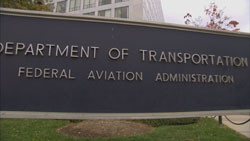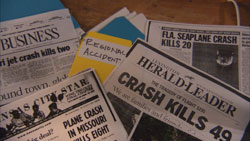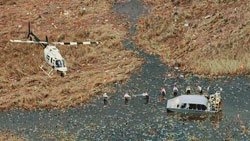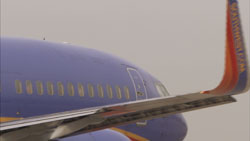
President Eisenhower signs the Federal Aviation Act, formally creating the Federal Aviation Agency (FAA). The new independent agency is tasked with both regulating and promoting civil aviation.
"It was a young, infant industry; and it needed to be promoted," explains FAA Administrator Randy Babbitt. But critics, including former Department of Transportation Inspector General Mary Schiavo, say this dual mandate created an inherent conflict for the FAA. "Their job was to promote aviation, and what they did is protected carriers to keep them flying," she charges.
President Carter signs the Airline Deregulation Act, which removes government control over fares, routes and the creation of new commercial airlines. The changes introduce a surge of competition, driving prices down. Today, customers are paying on average half as much for airfare as back then. But airlines have struggled, losing a cumulative $20 billion since 1980.

Following deregulation, airlines enter into a major restructuring phase, with a slew of airline consolidations and bankruptcies. A combination of rising fuel prices and new competition helps send airlines like Continental, Braniff and a rash of regional airlines into bankruptcy.
The industry begins organizing operations into a "hub-and-spoke" system. Major airlines create central "hubs" in big cities and turn to regional or commuter airlines to deliver passengers from smaller cities.
Some struggling airlines see a way to save money by outsourcing operations to smaller regionals. In 1984, Delta contracts with Comair, a regional airline based in Cincinnati, to fly shorter regional routes under the brand name of Delta Connection. Others create their own feeder networks; for example, American starts American Eagle to begin feeding its hubs.
In 1986, Continental forms Continental Express by purchasing a series of small regional airlines, including Houston's Royale Airways, Denver's Pioneer and Honolulu's Mid Pacific Air. But eventually, under former CEO Gordon Bethune, Continental changes its approach and begins contracting out its regional flights. "It's like anything else," Bethune explains to FRONTLINE. "We don't do our own engine maintenance; we let the manufacturer do that for us. They do it more effectively."

In reaction to a 67 percent increase in commuter/regional accidents in the early 1990s -- eight fatal accidents in 1991 alone killed 77 people -- the U.S. General Accounting Office releases a report called "Commuter Airline Safety Would Be Enhanced With Better FAA Oversight." According to the GAO, FAA inspections had not kept up with the growth of commuter airlines (then defined as companies with scheduled flights on aircraft with 30 or fewer seats).
At the time, commuter/regional airlines are governed under what's known as Part 135 regulations -- less stringent than the Part 121 regulations that govern the major airlines.
Another fatal airline crash in 1994 -- 68 passengers die when an American Eagle regional turboprop plane crashes in Roselawn, Ind. -- leads many in the industry to ask for "one level of safety," where the smaller regional airlines would be governed under the same regulations as the majors. In December 1995, the FAA moves regionals with 10 or more seats under the same regulatory regime as the major airlines.

All 110 people aboard are killed. A National Transportation Safety Board investigation indicates that a fire in the cargo compartment, possibly stoked by hazardous material allowed on at the last moment, is the probable cause. It blames SabreTech, an outsourced maintenance company, for improperly transporting dangerous cargo and ValuJet for failing to oversee SabreTech. The NTSB also faults the FAA for failing to appropriately oversee ValuJet's maintenance operations.
The previous year the FAA had indications of safety issues at ValuJet -- a fire breaks out in the cabin of ValuJet Flight 597, but the crew is able to safely abort the takeoff. NTSB inspectors fault the contractor to whom the airline outsourced maintenance operations for failing to perform an inspection and poor maintenance record keeping.
Concerned about the FAA's oversight of ValuJet, then-Department of Transportation Inspector General Mary Schiavo conducts her own investigation of the company.
"We found things like duct tape on the planes, cracked windshields and windows and violations on minimum equipment lists -- things that you must carry to have a safe flight," she tells FRONTLINE, recalling how her inspectors saw FAA regulators offering waivers on numerous safety issues that could have slowed the company's success. "Instead of hitting them with violations, [the FAA was] propping them up," she says.
President Clinton signs the Federal Aviation Administration Reauthorization Act of 1996. Following public outcry over the ValuJet Flight 592 crash, lawmakers approve changes to the FAA's mission that appear to remove the agency's dual mandate of regulating safety and promoting industry development.
But a closer look at the bill tells a different story. "There's a footnote in that legislation before Congress," Schiavo explains. "The footnote says: 'Although we're changing the terminology from "promote" to "encourage," we do not intend to change the way we do business. This is a change for the public consumption, and we're not changing how we work at the FAA.' It was simply a sleight of hand."
The development of smaller jet aircraft revolutionizes the regional industry, which can now fly farther, faster and more smoothly. "At that point, no longer were they constrained by a 400-mile radius," says William Swelbar, an airline researcher at MIT. "We now had an airplane that could expand the reach of a hub up to 1,200 miles."
In 1998, American Eagle announces it will acquire small jet airplanes for its regional routes. Two years later, Delta orders 500 regional jets. More and more the regionals begin cutting into the major airlines' market share.
After a profitable stretch in the 1990s, airlines begin to struggle in 2000 with the onset of intense ticket price competition driven by Internet searches. After 9/11, airlines experience even further pressure to cut prices and costs. US Airways, United Airlines, Delta and Northwest all file for bankruptcy by 2005.
FAA Administrator Marion C. Blakey announces the agency's new Customer Service Initiative. The policy identifies the airlines as the agency's "customers" and encourages them to bring concerns about the results of any inspector's findings to the FAA.
Nick Sabatini, who was the FAA's head of aviation safety from 2001 to 2008, tells FRONTLINE that the initiative was intended to address a lack of consistency and standardization across FAA offices. "It was never intended in any way to diminish the importance in who the real customer is," he explains. "The real customer is the public of these United States. We never lost sight of that regardless of what anybody says."
But critics, including Clay Foushee, a former Northwest Airlines executive who now works as an investigator for the House Transportation and Infrastructure Committee, say that the FAA's collaborative approach went too far. "It sent the message that, 'Look, I can cut a deal,'" he tells FRONTLINE. "All you had to do was make a phone call to somebody you had become friends with over the years and request reconsideration, and it would be taken care of."
The six fatal airline accidents in this period in the U.S. all involve regionals:
- Jan. 8, 2003: Air Midwest Flight 5481, flying under a code share as US Airways Express, crashes in Charlotte, N.C., killing 21. The NTSB investigation cites deficiencies in Air Midwest's oversight of outsourced maintenance as a contributing cause.
- Oct. 14, 2004: Pinnacle Airlines Flight 3701, operating under a code share as Northwest Airlink, crashes in Jefferson City, Mo., killing two crew members who were repositioning the plane to another airport after routine maintenance. The NTSB cites poor airmanship, unprofessional behavior and deviation from standard operating procedures as probable causes.
- Oct. 19, 2004: Corporate Airlines Flight 5966 crashes in Kirksville, Mo., killing 13. NTSB investigators cite pilots' failure to follow established procedures as a probable cause and pilot fatigue as a contributing cause.
- Dec. 19, 2005: A seaplane, operated by Flying Boat Inc., but flying as Chalks Ocean Airways Flight 101, crashes in Miami, killing 20. The NTSB cites Chalks' inadequate maintenance program and the FAA's failed oversight of the airline as probable causes.
- Aug. 27, 2006: Comair Flight 5191, operating under a code share as Delta Connection, crashes in Lexington, Ky., killing 47 passengers and two crew members. One crew member survives. The final NTSB report cites pilot performance as probable cause and nonpertinent conversation by crews as a contributing cause.
- Feb. 12, 2009: Continental Flight 3407, a Colgan Air-operated plane flying under a code share as Continental Connection, crashes outside of Buffalo, N.Y., killing all 49 onboard and one on the ground. NTSB cites the captain's inappropriate response to a stall, unprofessional pilot behavior, and Colgan Air's inadequate procedures for flying in icing conditions as probable causes.

Dozens of Southwest Airlines are grounded after the company reveals it continued to fly 46 jets that were out of compliance because of missed mandatory inspections for dangerous cracks in the outer skin. Public outrage grows when it is revealed that FAA inspectors knew about the missed inspections and allowed the planes to continue to fly. Southwest is ultimately fined $10.2 million -- the largest fine in FAA history.
In hearings a month later, Rep. James Oberstar (D-Minn.), chair of the House Transportation and Infrastructure Committee, describes it as "the most serious lapse in safety … in the past 23 years." Two FAA whistleblowers, Bobby Boutris and Doug Peters, testify at the hearings about the agency's coziness with the airlines.
In response to the crash of Continental Flight 3407 outside of Buffalo, new FAA Administrator Randy Babbitt issues a "Call to Action" on airline safety and pilot training. The initiative asked regulators, airlines and labor unions to come together to suggest improvements in the areas of fatigue, inspections and pilot training practices.
FAA Administrator Babbitt changes the name of the Customer Service Initiative policy to "Consistency and Standardization Initiative." According to a memo posted on the FAA's Web site, the newly named policy "emphasizes the original intent [of the Customer Service Initiative] to ensure consistent interpretation and implementation of agency regulation and policies." The memo notes that since February 2004, the agency has processed 350 appeals under the initiative.
The House of Representatives passes H.R. 3371, the Airline Safety and Pilot Training Improvement Act of 2009. The bill, which has not been voted on by the Senate, mandates airlines provide more training for pilots, raise the minimum number of flying hours to become an airline pilot from 250 to 1,500, and institute new standards for preventing pilot fatigue.